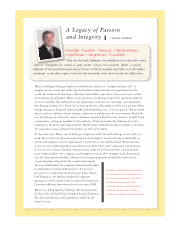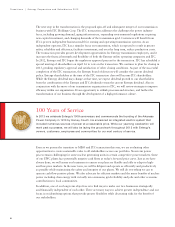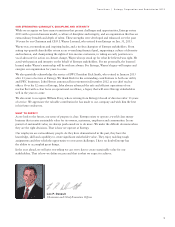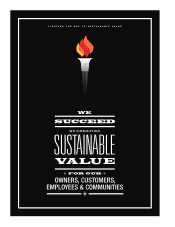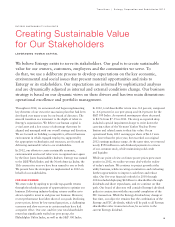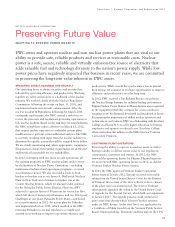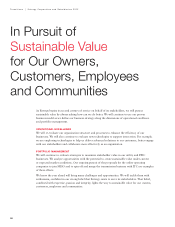Entergy 2012 Annual Report Download - page 17
Download and view the complete annual report
Please find page 17 of the 2012 Entergy annual report below. You can navigate through the pages in the report by either clicking on the pages listed below, or by using the keyword search tool below to find specific information within the annual report.
We will redouble our efforts in Texas. In September 2012,
the Public Utility Commission of Texas ruled on the rate case
filed by Entergy Texas, providing a $27.7 million base-rate
increase and a 9.8 percent allowed ROE. Entergy Texas was
denied recovery of approximately $30 million of purchased
power capacity costs that were determined to not be known
and measurable changes to test year amounts, which means
Entergy Texas will be unable to earn the low allowed ROE
granted. Entergy Texas is pursuing strategies to reverse or
mitigate the effects of the order and maintains the option to
file a new base rate-case should that be necessary.
One consideration in the rate case filings and other ongoing
retail proceedings is the impact historically low interest rates
could have on allowed ROE levels. It is noteworthy that the
average awarded electric ROE in the United States was 10.15
percent in 2012 − generally in line with the last approved ROEs
for most of our utilities. The total regulatory framework,
however, not just allowed ROEs, is key to the ability to earn
a fair return on utility investment in infrastructure. Over
the years, Entergy’s regulators have approved constructive
policies, such as the certification of large projects in advance
of construction, the approval of riders for specific types of
costs and FRPs, that help us achieve our objectives for our
customers and other stakeholders. We will continue to
advance innovative and effective regulatory constructs and
policies that benefit all stakeholders.
GROWING EARNINGS, DELIVERING STAKEHOLDER VALUE
During a time of increased industry-wide investment, Entergy
utilities generally have the benefit of constructive regulatory
relationships, manageable environmental exposure and
service territories with solid economic growth. By operating
efficiently, investing productively and working with our
regulators, our current five-year financial outlook indicates
utility net income compound annual average growth of
around 6 percent through 2014 off a 2009 base year,
including the transmission business.
We will prepare in 2013 for the integration of our utilities’
transmission and generation operations into MISO, and
we will continue to seek approval for the proposed spin-off
and merger of the transmission business with ITC.
Transforming our utility transmission business offers a
unique and significant opportunity to deliver value to our
customers and other stakeholders.
Transforming Our Transmission Business
Electric transmission presents challenging issues for the power industry, including the need to upgrade aging
infrastructure, modernize equipment to accommodate demand for complying with growing regulatory requirements,
and work to realize the vision of an efficient, inter-regional, high-performance grid. The proposed spin-off and merger
of Entergy utilities’ electric transmission businesses with a subsidiary of ITC Holdings Corp. is a significant step
forward in addressing these issues.
ITC’s proven independent business model for owning and operating transmission systems is the optimal model for
customers, owners, employees and communities. With its singular focus on transmission, ITC has a demonstrated
ability to operate transmission systems at industry-leading levels of safety and reliability. ITC’s independence fosters
a robust wholesale market and will bring necessary confidence to all stakeholders as we together face the challenges
and opportunities of modernizing the U.S. electric grid. ITC will bring a regional view to transmission planning and
operations that will include transparent collaboration with all stakeholders; by increasing stakeholder engagement
and confidence, the ITC transaction will facilitate and build on the benefits of MISO membership, which in turn is
expected to translate into savings for our customers. The regulatory approval process for the ITC transaction is under
way, with filings made in all jurisdictions. In January 2013, we cleared review under the Hart-Scott-Rodino Act without
action. ITC has scheduled a special meeting of shareholders on April 16 to vote on the transaction. We continue to
target a 2013 close, subject to satisfaction of certain closing conditions.
Entergy utilities secured retail regulatory orders subject to terms and conditions granting their requests to join MISO,
a necessary first step in realizing the value of an optimized transmission and generation system. Joining MISO is
expected to deliver approximately $1.4 billion in customer savings in the first 10 years. In addition, it paves the way
for Entergy Arkansas and Entergy Mississippi to exit the System Agreement in 2013 and 2015, respectively. The
targeted cutover to MISO is in December of 2013.
Even as we perform the extensive implementation activities required for transfer of control to MISO later this year, we
continue to reliably operate our transmission business in conformance with all requirements and continue to invest in
upgrades and expansions.
Transitions | Entergy Corporation and Subsidiaries 2012
15


